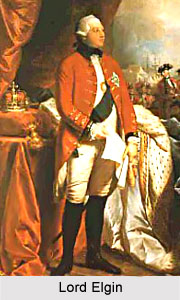 The Bundelkhand district of Agra Province had gone through rough patches of drought in the autumn of 1895 as a result of poor summer monsoon rains. When the winter monsoon failed too, the provincial government declared a famine early in 1896 and began to coordinate relief works. However, the summer monsoon of 1896 brought only scanty rains and soon the famine had spread to the United Provinces, Central Provinces and Berar, portions of the Bombay and Madras presidencies and of the provinces of Bengal, Punjab and even Upper Burma. The native states affected were Rajputana, Central Indian Agency and Hyderabad. The famine mostly affected the pan British Indian territory. Of the total area of 307,000 square miles affected, 225,000 square miles lay in British territory; similarly, of the total famine-afflicted population of 67.5 million, 62.5 million lived in British territory.
The Bundelkhand district of Agra Province had gone through rough patches of drought in the autumn of 1895 as a result of poor summer monsoon rains. When the winter monsoon failed too, the provincial government declared a famine early in 1896 and began to coordinate relief works. However, the summer monsoon of 1896 brought only scanty rains and soon the famine had spread to the United Provinces, Central Provinces and Berar, portions of the Bombay and Madras presidencies and of the provinces of Bengal, Punjab and even Upper Burma. The native states affected were Rajputana, Central Indian Agency and Hyderabad. The famine mostly affected the pan British Indian territory. Of the total area of 307,000 square miles affected, 225,000 square miles lay in British territory; similarly, of the total famine-afflicted population of 67.5 million, 62.5 million lived in British territory.
In the year of 1896, the monsoons of Western India similarly failed to make any watery impact and the subsequent 1896-97 drought placed three and a half million Indians on famine relief by the end of the year. The famine occurred mainly in Bombay and in segments of western India, parts of Rajputana, central India and the south-east region of Punjab. Relief measures included relief work projects, poor houses and the remission and suspension of land revenue.
Although large-scale relief was offered throughout the famine-stricken regions according to the Provisional Famine Code of 1883, the mortality, both from starvation and accompanying epidemics, was extremely high. Approximately 1 million people were believed to have died as a result of the famine.
In January 1897, the Indian Charitable Relief Fund was established in Calcutta and subsequently received gifts from other parts of India and throughout the world for famine relief. In December of that year, Lord Elgin appointed the Indian Famine Commission with Sir James B. Lyall (1838-1916) as its chairman. The Commission reviewed the existing Famine Codes in terms of the ongoing famine experiences in pan Western India.
In October 1898, the Famine Commission`s report affirmed the present Code`s practices and updated aspects of the public works relief projects. Additional provisions were recommended for the communities of weavers, forest-tribes and aboriginal hill tribes.



















